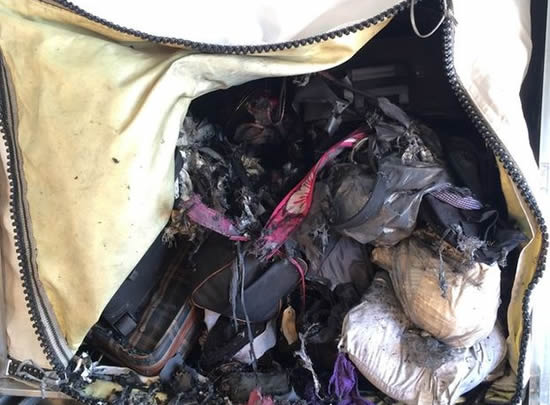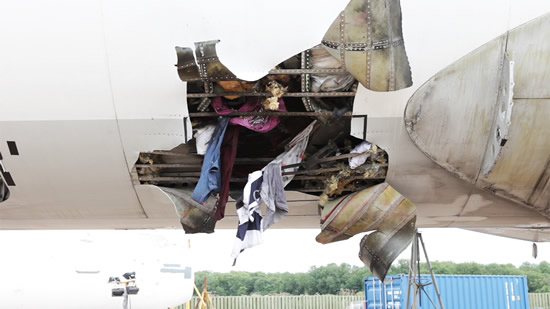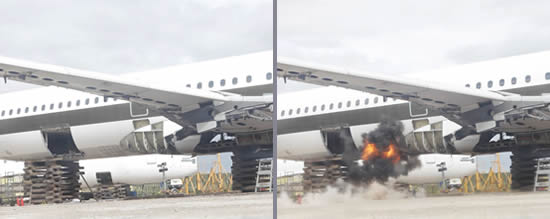Flexible bag effectively bomb-proofs planes
A four-layer bag has been successfully tested as an innovative means of thwarting terrorist attacks on commercial flights. Named FlyBag, the device can be used as a blast-, vibration- and heat-resistant container for hold luggage, offering a balance of strength and flexibility to protect the plane and its occupants from the explosive force of a bomb.
The FlyBag's lightweight construction is based on four different material layers, one incorporating Kevlar, which will withstand 3000°C heat and flames in the event of a bomb detonation, contain the high-pressure shockwave released by an explosive device and resist the impact of blast shrapnel, luggage and contents. Current devices which negate bomb blasts are made from tough, heavy materials - increasing cost and reducing a plane's available weight. The flexible design allows the bag to expand as the gases released by an explosion build up rapidly inside the hold, causing what is known as ‘quasi-static pressure’.

Post-blast, luggage inside the bag is shredded, but the plane holding the device remains intact.
The FlyBag project is funded by the European Commission and is run by a consortium of institutes and specialist companies, including Blastech, a spin out company from the University of Sheffield, as well as partners from Greece, Spain, Italy, Germany, Sweden and the Netherlands. The FlyBag was tested at the project's laboratory in Buxton, proving its worth as it shielded an Airbus A320 from an explosive detonation. The same bomb, detonated without the use of FlyBag, ripped apart the plane's underside - which would result in a likely-fatal explosive decompression at 37,000 feet.

The skin of a plane is ruptured by an unshielded bomb.
“We're delighted with the way the trials have gone. We've previously tested FlyBag at our laboratory in Buxton but just in the open air,” said Dr Andy Tyas, a specialist in explosives engineering from the University of Sheffield and a director of the spin-out firm Blastech. “We knew the bag expanded and the question was: how much did that expansion cause a problem for the airframe? Does that become the devastating transmitter of energy itself? And what we're seeing is, it's not doing that.”
“I witnessed one test for myself in which a rucksack containing a bomb was placed with other luggage inside a FlyBag in the hold of an old Airbus A320” continued Dr Tyas. “An equivalent bomb had a devastating impact on the airframe without the containing device. From a safe distance, we could hear the detonation but could not see any visible effect. After the air and dust had cleared, I was shown how the explosion had charred some of the luggage but the bag itself had remained intact with no sign of any impact on the aircraft. The significance is that if a bomb the same size had exploded during a flight, it would not have been catastrophic and any passengers on board would have survived.”
Disasters such as the Lockerbie bombing in 1988 drove the need for this kind of invention, as well as an incident in which a printer cartridge bomb was found on-board a cargo plane at East Midlands Airport in 2010.
 A test with (left) and without (right) the FlyBag - showing the relative lack of damage when the protective device is used. In contrast, the FlyBag-less plane's hull is breached.
A test with (left) and without (right) the FlyBag - showing the relative lack of damage when the protective device is used. In contrast, the FlyBag-less plane's hull is breached.
Italian airline Meridiana has been the first company to show interest in the FlyBag, hoping to certify a version which will hang inside the hold of a narrow-body jet. A second type of bag will fill the cargo hold of a wide-body aeroplane such as a Boeing 747 or Airbus A380, whilst a third, smaller design could be kept in the cabin, for use in the case of a passenger displaying a terror threat.
“We have all the ingredients to go to market - we just needed these latest tests to prove the system,” said Project Coordinator Donato Zangani, of the Italian consulting company D'Appolonia. “The technology of the materials is not new but the combination of them is novel - and the trick is to be able to have a fabric only 1.3mm thick but also absorb the pressure in a predictable way. It's about staying one step ahead.”
The FlyBag could one day be a mandatory requirement for civil aviation, offering a last-gasp layer of protection designed to save lives after every other security measure has failed.










